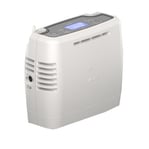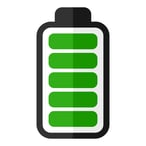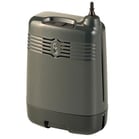
When it comes to oxygen concentrators, Inogen, Inc. is a company that continuously puts out high-quality and reliable products. The latest product in their “G” series of portable oxygen concentrators, the Inogen One G5, is just one example of how their hard work and innovation has improved the lives of countless respiratory patients around the world.
However, if you’ve done a bit of research on oxygen concentrators, you know that there are a lot of things you need to know before making a purchase. Simply putting your money down for the “best” portable oxygen concentrator isn’t usually an option because each patient has entirely different wants and needs.
In order to help you better understand the Inogen One G5, we’ve put together a list of some interesting and potentially lesser-known facts about it. By doing so, you’ll be able to make a more educated decision about which concentrator is right for you.
As always, if you have any questions or concerns about oxygen concentrators, it’s best to speak with a respiratory specialist who will work to understand your needs and align you with the unit that will best serve you in the long term. With the Inogen One G5, you’ll have plenty of breathing room in case your trip lasts longer than you expected.
What is the Inogen One G5?
The Inogen One G5 is the latest portable oxygen concentrator by Inogen. It was released in the summer of 2019 and is widely considered to be one of the most advanced concentrators on the market. The G5 is a pulse flow machine meaning that it detects your breathing and only delivers oxygen when you inhale as opposed to continuous flow concentrators that deliver a constant stream of oxygen.
The G5 delivers on Inogen’s goal to provide respiratory patients with a reliable and powerful oxygen machine that allows them to regain their freedom and independence. Unlike continuous flow concentrators and oxygen tanks which need to be wheeled around on a cart, the G5 can easily be carried over your shoulder or in a backpack.
.png?width=210&name=G5-Oxygen-Concentrator_418x418-removebg-preview%20(1).png)
With previous iterations in the “G” series of portable oxygen concentrators, Inogen experimented with a lot of design types. The Inogen One G2, for example, had a high oxygen output and decent battery life, however, it was pretty heavy for a pulse flow portable oxygen concentrator. As a result, most people found it more convenient to use a carrying cart with it.
On the other side of the spectrum is the Inogen One G4. This unit was released several years ago and aimed to be the lightest portable oxygen concentrator ever produced. Unfortunately, this came at the cost of oxygen output which only went up to a flow setting of 3. This meant that this unit was off-limits to many oxygen patients who needed a higher flow setting.

When the Inogen One G5 released, it broke the mold by offering respiratory patients the best of both of these oxygen concentrators. The Inogen One G5 has a high oxygen output, great battery life, and it’s very lightweight and easy to carry. While all pulse flow oxygen concentrators have their pros and cons, the Inogen One G5 remains the best machine for the greatest number of people.
1.) It Has the Longest External Battery Life of Any Portable Oxygen Concentrator
Potentially the most notable fact about the Inogen One G5 is that it has the longest external battery life of any portable oxygen concentrator ever produced. An external battery is one that’s not built into the device and can be removed and replaced with other batteries. In the case of the G5, the external battery is conveniently located on the bottom of the device and can be removed by pulling the tab on the side.

With the double battery (16-cell), the Inogen One G5 can run up to 13 hours on one charge. That’s more than enough to get you through a full day without needing to stop and plug it in. The only oxygen concentrators that surpass the battery life of the G5 are ones that have internal batteries, however, there are a number of problems with these units.
One of the main problems associated with internal batteries is that they can’t be replaced without the help of a professional. Unlike G5 batteries which can be installed or removed in a matter of seconds, you need to take apart the device in order to replace an internal battery.

Another problem with internal portable oxygen concentrator batteries is that they don’t afford you the freedom to choose how much battery life you use. While you can buy external batteries for units like the ResMed Mobi, they’re sold separately and only offer a few extra hours of battery life.

There’s no understating the importance of having a long battery life with your portable oxygen concentrator. Nobody likes being homebound and if you’re constantly having to worry about how long your POC will last before shutting off, you’re not going to be focused on living and enjoying your life.
2.) It’s one of the Lightest Portable Oxygen Concentrators
Another important metric of portable oxygen concentrators is weight. If you were to research oxygen therapy a decade ago, you probably would’ve never read the words “lightweight” and “oxygen device” in the same sentence. However, since their inception, portable oxygen concentrators have come a long way in offering a high flow of oxygen without adding weight.

The Inogen One G5 certainly doesn’t slack when it comes to its weight. At just 4.7 pounds, it’s the third lightest concentrator behind the AirSep Focus and the Inogen One G4. the problem is that neither of these offer the outstanding oxygen output and battery life that the G5 does.
There are a number of benefits to using a lightweight portable oxygen concentrator. First of all, you’ll be far less likely to become out of breath or experience an exacerbation while carrying a device like the G5. 4.7 pounds is not very much weight, it’s about the same weight as a 2-liter bottle of soda. That’s not enough to be a burden to you as you walk around and enjoy your day.
Another benefit of investing in a lightweight portable oxygen concentrator like the G5 is that you won’t have to deal with a rolling travel cart. Rolling carts are commonly used for oxygen concentrators that are over 10 pounds or so because they become too much of a burden to carry around on your shoulder.

Travel carts not only add weight to an already heavy oxygen concentrator, but they can be dangerous as well. If you’re using your concentrator while you’re walking, that means you need to have a cannula that runs from the device to your nose. If you’re not careful or you have a long cannula, it could easily get caught on something and cause injury.
Another downside to using a travel cart is that they take up a lot of room and you won’t be able to take them everywhere you need to. For example, if you’re walking down a gravel pathway, a muddy sidewalk, or you’re trying to get on a bus. This is why it’s difficult to recommend heavy oxygen concentrators because they don’t offer you true freedom in your day-to-day life.
3.) It Has the Highest Oxygen Output for its Weight
Having a lightweight oxygen concentrator doesn’t mean much if it doesn’t offer the oxygen output that you need. Fortunately, the Inogen One G5 is able to deliver on both and even has the highest oxygen output of any pulse flow unit for its weight. What this means is that you’re not carrying a bunch of unnecessary weight around.
Another thing this shows is that Inogen is focused on efficiency above all else. They understand that in order for you to get the most out of your portable oxygen concentrator, it needs to match your lifestyle and afford you the ability to go where you want and do what you want without weighing you down.

Despite offering the highest flow setting and overall oxygen output of any pulse flow portable oxygen concentrator, it’s still one of the lightest units available. For example, the AirSep Focus is the lightest portable oxygen concentrator ever produced weighing in at just 1.75 pounds. That’s pretty incredible, but the problem is that it only has one flow setting: a flow setting of 2. Many people require more oxygen than this.
Another unit lighter than the G5, the Inogen One G4, also lacks when it comes to oxygen output. The G4 weighs 2.8 pounds but can only supply a pulse setting of 3. What’s more, the G5 has over twice the battery life of the Inogen One G4. The G5, on the other hand, is the best of both worlds. It’s among the lowest POCs ever produced and has the highest flow setting of any pulse flow POC.
4.) It’s Designed for 24/7 Use
If you’ve had an electronic device such as a phone or computer die on you before, you may be afraid to run your portable oxygen concentrator 24/7. While every machine is different, the Inogen One G5, and many other Inogen concentrators, are actually designed to be used day and night.
This is great news for anyone who likes to sleep with oxygen therapy because it means you won’t have to buy a whole new home oxygen concentrator to use at night. This would be costly and add to the list of things you have to worry about. But thanks to the Inogen One G5’s Sleep Mode Technology, you’ll never have to worry about it.

When you sleep at night, your breathing changes significantly. Some people will sustain shallow breaths through their nose or mouth or their breathing rate may change the longer they sleep. Everyone has slightly different breathing patterns, but the G5 is able to detect even the most shallow breaths ensuring that you always have an adequate amount of oxygen.
Another reason the Inogen One G5 is great for 24-hour use is that its processor is set to last 20,000 hours. This is the most important part of the electrical components of your device and it’s responsible for ensuring you receive an accurate bolus of oxygen immediately upon inspiration. That’s about 2.3 years of persistent oxygen use!
5.) It Has its Own Mobile Application

In this day and age, staying connected is everything. If we’re away from our phones or computers for an extended period of time, it can feel like our whole world is caving in around us. Unfortunately, it can feel the same way if you aren’t able to check up on your POC every once in a while.
Inogen created a workaround for this allowing you to check the status of your concentrator with a mobile device like a tablet or smartphone. The Inogen Connect app can be downloaded for free on either Android or iPhone devices and can be connected to your Inogen One G5 in a matter of minutes.

Here are a few of the things you can check with the Inogen Connect app:
- Battery status
- Software updates
- Cannula and filter maintenance updates
- Column life
- Troubleshooting tips, FAQS, and the user manual
- Oxygen purity status
One of the greatest parts about this application is that it affords you more freedom to use your device how you please and live life on your own terms. Instead of having to keep your POC at your side all the time to check things like battery status, column life, and oxygen purity status, you can store your device under a seat or in a travel backpack without having to worry about it.
6.) It’s Approved by All Major Airlines
If you travel frequently, you know how much of a pain it is to deal with airlines. Between canceled flights, delayed takeoffs, and unbearable customer service, you may be tempted to just avoid flying altogether. Well we certainly couldn’t blame you for that, you may find some consolation in the fact that the Inogen One G5 is approved by all major airlines and they shouldn’t give you too much of a hassle about bringing it onto the plane.
.jpg?width=356&name=dreamstime_xxl_132434018%20(1).jpg)
There are, however, a few steps you should take before you fly with your Inogen One G5:
- Speak with your pulmonologist or primary care physician several days before your flight. Notify him/her that you will be traveling with medical oxygen. Ask for a doctor’s note or prescription that indicates your need for oxygen while in flight.
- A day or two before your flight, contact the airline that you will be flying with. Let them know that you will be flying with an oxygen concentrator. You may need to fax a copy of the physician’s note or arrive early to show it to them. This would be a good time to ask them any questions you may have about taking your concentrator onto the plane.
- Before you leave your home, make sure that you have at least 1.5 times as much battery life as your flight duration. Most airports have outlets near the boarding gates, so be sure to bring your AC adapter and charge your portable oxygen concentrator while you’re waiting for the plane.
- Once you arrive at the Transportation Security Administration (TSA) checkpoint at the airport, notify an employee that you will need to keep your oxygen on and need an alternate screening process.
- Finally, speak with an employee once you arrive at the gate to ensure your oxygen concentrator has been approved.

While the Inogen One G5 is approved by the Federal Aviation Administration (FAA), you should still take the steps listed above. Airlines can be tricky and if you wait until you arrive at your gate to notify them that you will be using oxygen, there could potentially be delays in your flight. Be sure to plan far enough ahead to avoid any complications.
Conclusion
Finding the right medical oxygen concentrator isn’t all about buying the most advanced one you can find, it’s more about finding the one that’s right for you and your lifestyle. However, given the numerous accomplishments of the Inogen One G5, it’s an ideal unit for many respiratory patients. While POCs like the AirSep Focus and Inogen One G4 are great for patients with low-flow oxygen needs, the G5 remains popular among people with both low and high oxygen flow needs.
If you have any trouble at all with choosing a medical oxygen concentrator, you have several options. Firstly, you can read the user manuals for the units that you’re interested in. These can easily be found with a quick Google search or on the manufacturer’s website. Another option is to look at comparison charts like we have on this blog. It’s always easier to narrow down your options when you can see the system specifications side-by-side. Lastly, you can get in touch with one of our respiratory specialists who can walk you through your options.


.png)




